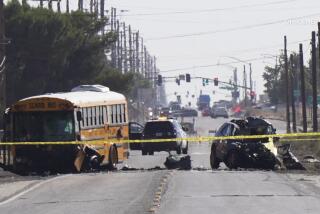Crash Renews Calls to Stop Forced Busing : Education: Many students, like those in the accident, are transported because of overcrowding.
- Share via
Of the 70,000 children who ride Los Angeles Unified buses daily, one in seven is on board because every seat in the neighborhood school is taken.
The children involved in Wednesday’s fatal bus crash came from four jam-packed schools near downtown and their fate renewed calls for alternatives to busing students to relieve overcrowding.
“We need to look at what put those children on those buses, and that is not having a neighborhood school . . . not having a choice,” said school board member Victoria Castro, whose district includes Glen Alta Elementary, where the bus was headed.
Considering the sheer number of students riding district buses each day, Castro and others expressed amazement that there have been no other bus fatalities or serious injuries in recorded district history.
But, Castro said, “Every day, whether there’s an accident or not, our parents put children on buses . . . with apprehension.”
In nearly 4,200 Los Angeles Unified bus accidents in the last six years, ranging from a broken mirror to a totaled bus, 770 pupils have been injured. But until Wednesday most injuries were minor and no one was hurt as badly as the boy who remained hospitalized after the crash and the two children who were killed.
District transportation officials attributed that track record largely to the 42 hours of intensive training required of all Los Angeles Unified bus drivers, regardless of experience.
The training emphasizes defensive driving, Transportation Director Antonio Rodriguez said. “We want our drivers to anticipate problems, not just react to them.”
In fact, Rodriguez said, the driver of the bus involved in Wednesday’s accident had tried to turn away from the garbage truck at the last minute.
The 48 children on the bus were among 10,000 students bused involuntarily from crowded areas daily. The only other pupils required to take buses are 14,000 of the district’s special education students. The remaining 45,000 bus riders are there by choice, most either headed to magnet schools or volunteer participants in the district’s desegregation program.
Responding to public and parental pressure, the district has worked hard in the last five years to scale back its busing program. Building schools, erecting portable classrooms, instituting year-round schedules and increasing class size have allowed crowded campuses to accommodate more students and cut the number of students who must be bused almost in half, from 17,000.
“The ideal is zero students bused,” said Bruce Takeguma, a district busing specialist. “You keeping working for that ideal.”
Forces conspiring to foil that goal are Los Angeles’ modern-day baby boom and voters’ rejection last year of a $1-billion statewide school building bond measure the district could have used for new facilities. A movement is now afoot among a coalition of educators to include a similar $3-billion measure on the March ballot.
In the neighborhoods east of Downtown--filled with young Korean and Latino immigrant families--overcrowding is particularly harsh, forcing thousands of children a day onto buses headed for schools in outlying areas.
Cahuenga Elementary should have been the home school for nine of the children on the bus involved in Wednesday’s accident. But in the last decade, enrollment there has nearly doubled to 1,200 students, Principal Lloyd Houske said. An additional 1,400 students from the neighborhood must be turned away each year.
Like other crowded schools, Cahuenga-area parents enter an unenviable enrollment race each year. The school registers the first new children who show up. The latecomers find themselves sending their children to one of 25 different schools, some of them miles away.
Attempted solutions appear feeble compared to the scope of the problem: A three-story building now under construction on the campus will not stop the exodus of children, but simply replace portable buildings that have been used as a stopgap, Houske said.
“The whole Mid-Wilshire area is facing this influx of new families,” he said. “We’ve already built four or five new schools, but it hasn’t been nearly enough. . . . The debate is, which is worse for the children? To have so many of them in this crowded setting or to have them bused away?”
Times staff writer Shawn Hubler contributed to this story.
* REMEMBERING VICTIMS: Brian Serrano and Francisco Javier Mata were best pals as only 8-year-olds can be. B1
More to Read
Sign up for Essential California
The most important California stories and recommendations in your inbox every morning.
You may occasionally receive promotional content from the Los Angeles Times.













